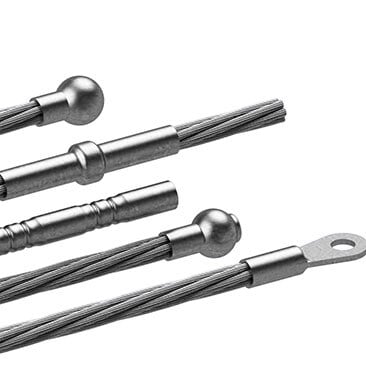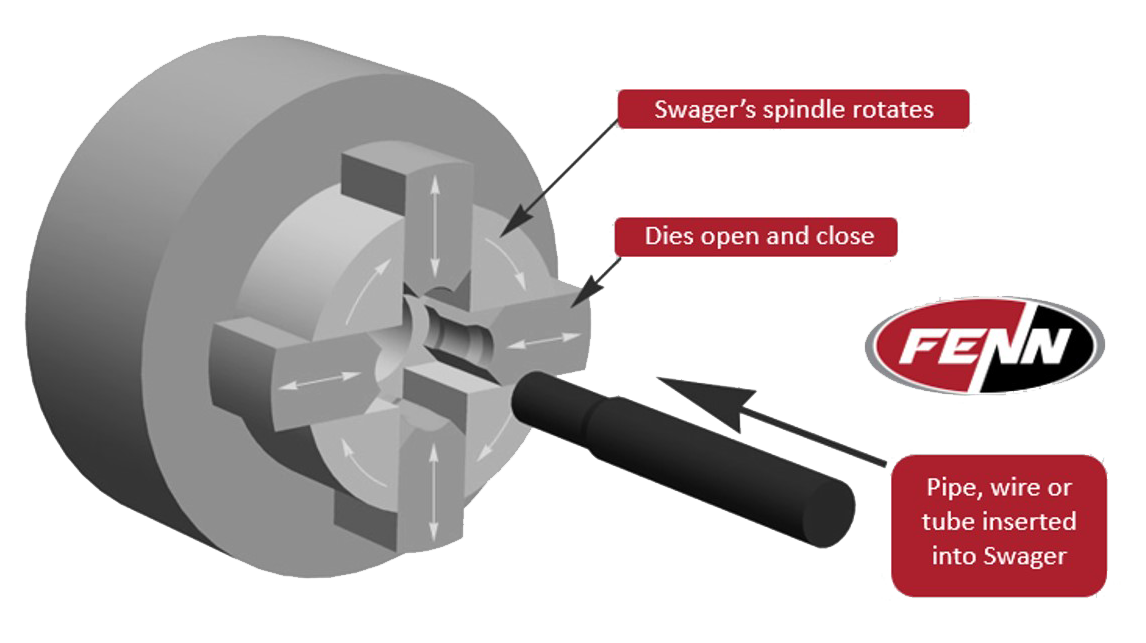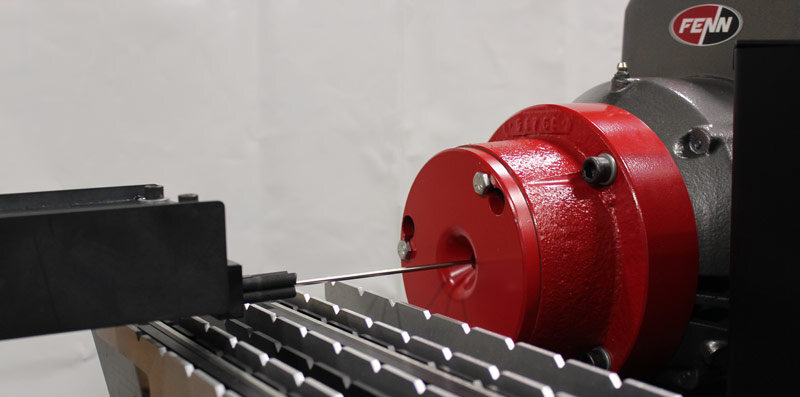Swaging Machines: What They Are and How They Work
FENN has been the choice for companies searching for an efficient, low-cost method of pointing, forming, and reducing wire, rod, and tube since 1900. Because of their dedication to creating and engineering metal forming solutions they can meet the unique requirements of their diverse customer base. FENN also serves a myriad of applications across a broad range of industries with the deep knowledge and expertise necessary to design and build customized metal forming equipment and swaging machines.
What is Swaging?
At its core, swaging is a metal forming method that is used to reduce rod, wire or tube. Unlike other methods, swaging uses a rapid succession of hammer strikes to form the metal. This chipless metal forming method, is an efficient way to produce products with minimal material waste. It is a highly economic method to point tubing, rod, and wire for redraw. It can also size, reduce, shape, taper, bond, or form metal parts.
Benefits of Swaging Machines
Swaging offers numerous benefits to companies who choose this method of metal forming.
- High finish – Because the end result includes a high finish, this can eliminate the need for secondary operations, saving both time and money.
- Speeds Assembly – Fittings can be attached to a variety of other components including wire cable, tubing, hose, flexible tubing, and rod. Tubes can also be easily crimped together.
- Less Material is Used – As the material is hammered, it is displaced longitudinally as opposed to being chipped away wastefully.
- Saves on Labor – Highly skilled operators are not essential. Several machines incorporating feeders and material handling systems can be tended by a single operator.
- Low-Cost & Flexible Tooling – With FENN Swagers, tooling is extremely flexible, and dies can simply and quickly be changed.
- Reduces Inventory Needs – Having the ability to swage to the exact sizes and finishes needed means that fewer components have to be kept on-hand.
- Control of Wall Thickness – With the use of a mandrel, swaging allows you to have more control of wall thickness throughout the process.
Basic Types of Swaging
Swaging machines can be used for three basic types of swaging.
- Assembling – When forming components such as recreational ropes course cables and sailing rigging equipment, a fitting is first placed over the cable. Then it is inserted into the swager where the hammers’ cold-force action produces an assembled piece.
- End Forming – One piece of tubing is inserted to a specific depth in the swager before it is reduced to the precise diameter required. At that point, the component can undergo secondary operations such as drilling, drawing, or tapping. Fluid control tubes, as well as aerospace tube components, are formed using this technique.
- Through Swaging/Reducing – Long lengths of cable, rod or tube are passed through the Swager. During the process the entire length of material is reduced to a smaller overall diameter, and the cold forging process produces a desired tensile strength. Examples include applications within the logging industry and the production of cartridge heaters used in the renewable energy industry.
Types of Swagers
- Rotary Swagers – For design components that require symmetrical pieces, a Rotary Swager is the preferred choice. Its hammers and dies revolve precisely around the work, resulting in pieces with a superior finish. FENN offers nine basic Swager sizes with capacities ranging from 1/16” up to 3-3/8” for solid, and 1/4” to 6” for tubing.
- Stationary Die Swagers – For non-circular cross sections. Because the dies and hammers to not revolve in a Stationary Die Swager, it is possible to forge asymmetrical shapes. FENN offers two types: simultaneous blow (fluted shapes, cross circular sections) and the patented alternate blow (rectangular shapes, squares, and hexagons).
- Long Die Swagers – For designs that are long and shallow in nature, the Long Die Swager from FENN produces taper tubing up to 24” long. A diverse selection of nonferrous and ferrous materials can be used with Long Die Swagers. Products for the aerospace, sporting goods, and home furnishings industries can be created using this method.
Swager Feeding Systems
Easily optimize your swaging operation, increase operator safety, and improve productivity with a FENN Feeding System. Engineered to be accurate and durable for decades of sustained use, FENN recommends that every swager should have a Feeding System.
Industries Served
FENN swaging machines serve some of today’s most crucial industries, including the military, automotive, and medical.
- Military – Within the military industry, swaging is used to form items such as gun barrels and anti-tank rocket tips. MS-spec fittings are also swaged into cable.
- Automotive – Many automobile components, including the assemblies for emergency brake cables, steering components, and drive shafts, are formed using swaging machines.
- Medical – Hypodermic needles, catheter band assemblies, and optical instruments are just a few of the many medical products that undergo swaging.
- Renewable Energy – Cartridge heaters, superconducting material, and zirconium rod — items that the renewable energy industry relies upon — can be expertly machined using FENN swaging machines.
- Aerospace – By swaging, the aerospace industry is assured of high-quality control rods, wire rope cable assemblies, and fluid transfer tubing.
When it comes to metal forming equipment, FENN is an industry leader in Swager manufacturing. Backed by superior customer service, FENN is here to help you increase production quality, quantity, and profitability by providing metal forming solutions to meet your needs.
If you’re ready to get started with a Swaging Machine or if you want information on other machines such as Rolling Mills, Drawbenches, Spring Coilers, and more, call 860.259.6600 or contact FENN today.




